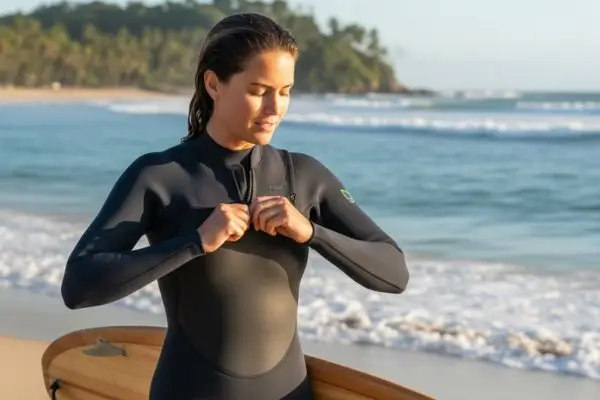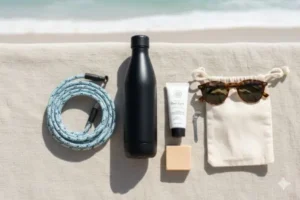When you think about surfing, a wetsuit is often just as essential as the board itself — especially in cooler waters. For women surfers who care about the planet, the decision goes beyond comfort and flexibility. Eco-friendly wetsuits are transforming the way surfers approach gear, offering options that perform well in the water while reducing harm to the environment.
The Environmental Cost of Traditional Wetsuits
Most wetsuits are made with neoprene, a synthetic rubber derived from petroleum. While neoprene is durable and insulating, it comes with a heavy environmental footprint:
- Energy-Intensive Production: Petroleum-based neoprene contributes to greenhouse gas emissions.
- Non-Biodegradable Waste: Old wetsuits often end up in landfills, taking decades to break down.
- Toxic Byproducts: Manufacturing processes release harmful chemicals.
For surfers who spend hours immersed in nature, using gear that harms the ocean feels contradictory. That’s why eco-friendly wetsuits have become a game-changer.
What Makes a Wetsuit Eco-Friendly?
Eco-conscious wetsuits are designed to reduce environmental impact without compromising performance. Key features include:
- Alternative Materials: Natural rubber, limestone-based neoprene, or recycled fabrics.
- Sustainable Production: Factories powered by renewable energy or with reduced water use.
- Long-Lasting Durability: Products built to extend the lifespan and reduce waste.
- Recycling Programs: Brands offering wetsuit recycling initiatives.
These innovations are making it easier for women surfers to choose gear that aligns with their values.
Materials Used in Eco-Friendly Wetsuits
Here are the most common alternatives replacing petroleum-based neoprene:
- Yulex® Natural Rubber: Derived from sustainably harvested rubber trees, with low CO₂ emissions.
- Limestone Neoprene: Made from limestone instead of petroleum, with a lower carbon footprint.
- Recycled Fabrics: Wetsuits with linings or outer layers from recycled plastics or nylon.
- Plant-Based Blends: Combining natural rubber with eco-friendly synthetics for flexibility.
Each option offers different levels of warmth, durability, and stretch — but all represent a step toward sustainability.
Step-by-Step Guide to Choosing an Eco-Friendly Wetsuit
1. Define Your Surf Conditions
Are you surfing in tropical waters or cold breaks? Warmer climates may only require a thin spring suit, while colder waters need full suits with thicker insulation.
2. Check for Women-Specific Designs
Eco wetsuits are increasingly tailored for women, with fits that improve comfort and mobility. Look for designs with added flexibility around shoulders and hips.
3. Compare Eco Materials
Decide whether natural rubber (like Yulex) or limestone neoprene better fits your needs. Natural rubber is the most sustainable, while limestone neoprene is often more affordable.
4. Evaluate Brand Commitments
Brands such as Patagonia, Picture Organic Clothing, and Soöruz are leaders in eco-friendly wetsuits. Research their sustainability policies before purchasing.
5. Look for Certifications
Some wetsuits come with certifications that guarantee eco standards, like the Forest Stewardship Council (FSC) for natural rubber.
6. Balance Budget and Longevity
Eco wetsuits may cost more upfront but often last longer, reducing the need for replacements. Consider it an investment in both performance and sustainability.
7. Care for Your Wetsuit Properly
Rinse with fresh water after every session, hang to dry in the shade, and avoid leaving it in hot cars. Proper care extends its life and maximizes the value of your eco purchase.
Top Eco-Friendly Wetsuits for Women
- Patagonia R1 Yulex Wetsuit: Made from FSC-certified natural rubber, ideal for cold water.
- Picture Organic Dome Wetsuit: Features recycled linings and water-based glues.
- Soöruz Guru+ Wetsuit: Combines natural rubber and innovative eco-resins.
- Vissla 7 Seas Eco Wetsuit: Uses limestone neoprene and recycled polyester.
Each of these wetsuits offers excellent performance while addressing environmental concerns.
Beyond the Wetsuit: Creating a Full Eco Surf Kit
Your wetsuit is just one part of the surf experience. Pair it with other eco-conscious gear to build a complete sustainable setup:
- Recycled or plant-based surf leashes.
- Biodegradable surf wax.
- Recycled wetsuit bags for transport.
- Repair kits to extend the life of your wetsuit.
These small changes add up, making your surf lifestyle more harmonious with the ocean.
A Commitment to the Ocean
Choosing an eco-friendly wetsuit as a woman surfer is more than a gear decision — it’s a statement of values. It shows that you care about your comfort in the water while also protecting the very waves you ride. Every time you zip up an eco wetsuit, you’re making a conscious choice to reduce harm and contribute to the preservation of the ocean for future generations of surfers.
The path to sustainable surfing starts with small, intentional decisions. Your wetsuit can be the first — and most empowering — step in aligning your passion for surfing with your love for the planet.




